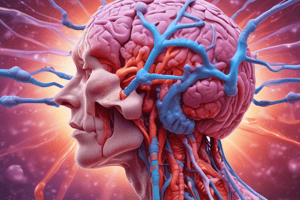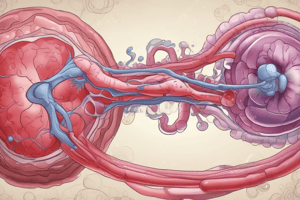Podcast
Questions and Answers
Which of the following best describes the focus of general pathology?
Which of the following best describes the focus of general pathology?
- Diseases affecting specific organ systems, integrating broad pathological principles.
- The examination of diseases caused by genetic mutations and inherited conditions.
- The study of diseases related to infections and the body's immune response to pathogens.
- Fundamental reactions of cells and tissues to abnormal stimuli, irrespective of specific organ systems. (correct)
Which of the following cellular adaptations involves a change in cell type?
Which of the following cellular adaptations involves a change in cell type?
- Hypertrophy
- Hyperplasia
- Metaplasia (correct)
- Atrophy
What is the primary distinction between necrosis and apoptosis?
What is the primary distinction between necrosis and apoptosis?
- Necrosis causes inflammation; apoptosis does not. (correct)
- Necrosis is reversible; apoptosis is irreversible.
- Necrosis is a programmed process; apoptosis is due to injury.
- Necrosis only occurs in malignant tumors; apoptosis in benign tumors.
In tissue repair, what is the key difference between regeneration and fibrosis?
In tissue repair, what is the key difference between regeneration and fibrosis?
An individual is exposed to asbestos and subsequently develops mesothelioma. Which branch of pathology is most relevant to this disease?
An individual is exposed to asbestos and subsequently develops mesothelioma. Which branch of pathology is most relevant to this disease?
How do benign tumors differ from malignant tumors?
How do benign tumors differ from malignant tumors?
What role does understanding disease pathogenesis play in healthcare?
What role does understanding disease pathogenesis play in healthcare?
The body's ability to maintain a stable internal environment is known as:
The body's ability to maintain a stable internal environment is known as:
In an infection, what is the relationship between the pathogen's virulence and the host's immune status?
In an infection, what is the relationship between the pathogen's virulence and the host's immune status?
Which of the following techniques involves using antibodies to detect specific proteins in tissue samples for diagnostic purposes?
Which of the following techniques involves using antibodies to detect specific proteins in tissue samples for diagnostic purposes?
Flashcards
Pathology
Pathology
The study of disease, bridging science and medicine to investigate causes, mechanisms, and extent.
General Pathology
General Pathology
Focuses on fundamental reactions of cells and tissues to abnormal stimuli, irrespective of specific organ systems.
Systemic Pathology
Systemic Pathology
Examines diseases affecting specific organ systems, integrating general pathology principles.
Disease
Disease
Signup and view all the flashcards
Homeostasis
Homeostasis
Signup and view all the flashcards
Cellular Adaptations
Cellular Adaptations
Signup and view all the flashcards
Inflammation
Inflammation
Signup and view all the flashcards
Neoplasia
Neoplasia
Signup and view all the flashcards
Immunopathology
Immunopathology
Signup and view all the flashcards
Nutritional Pathology
Nutritional Pathology
Signup and view all the flashcards
Study Notes
- Pathology is the study of disease, bridging science and medicine
- It investigates disease causes, mechanisms, and extent
- Pathology divides into general and systemic branches
General Pathology
- Focuses on fundamental cell and tissue reactions to abnormal stimuli
- Covers common injury/stress responses, regardless of organ system
- Inflammation, the body's response to injury/infection, is key
- Cell injury/death are central concepts, including necrosis, apoptosis, and cellular adaptations
- Studies tissue repair and regeneration as the body attempts to restore normal structure/function
- Examines genetic and environmental disease factors
- Neoplasia (tumor formation) is a major area, covering benign and malignant growths
- Immunopathology studies the immune system's role in disease
Systemic Pathology
- Examines diseases affecting specific organ systems
- Integrates general pathology principles with each organ's unique characteristics
- Cardiovascular pathology addresses heart/blood vessel diseases like atherosclerosis and hypertension
- Respiratory pathology covers lung diseases like pneumonia, asthma, and COPD
- Gastrointestinal pathology includes diseases of the esophagus, stomach, intestines, liver, and pancreas
- Endocrine pathology focuses on hormone-producing gland disorders like the thyroid and adrenal glands
- Genitourinary pathology covers kidney, bladder, and reproductive organ diseases
- Nervous system pathology includes diseases of the brain, spinal cord, and peripheral nerves
- Musculoskeletal pathology focuses on bone, joint, and muscle diseases
- Hematopathology deals with blood/bone marrow diseases, including leukemia and lymphoma
Disease
- It's any deviation from or interruption of normal body structure/function
- It arises from interplay of genetic predispositions, environmental influences, infectious agents, and lifestyle choices
- It manifests as subtle biochemical changes to overt structural/functional abnormalities
- Disease pathogenesis refers to the sequence of events from the initial cause to the disease's manifestations
- Understanding pathogenesis is essential for effective prevention, diagnosis, and treatment
Homeostasis
- The body's ability to maintain a stable internal environment despite external changes
- Achieved through regulatory mechanisms, including feedback loops and hormonal/nervous system control
- Cellular adaptation is the primary mechanism defending against injury
- Maintaining homeostasis is essential for normal cellular function and survival
Cellular Adaptations
- Reversible changes in cell structure/function in response to environmental changes
- Adaptations: hypertrophy, atrophy, hyperplasia, metaplasia, and dysplasia
- Hypertrophy: increased cell size, leading to increased organ size
- Atrophy: decreased cell size, leading to decreased organ size
- Hyperplasia: increased cell number
- Metaplasia: change in cell type
- Dysplasia: disordered cell growth and maturation, a premalignant condition
Cell Injury and Cell Death
- Cell injury occurs when cells are exposed to stress, damaging stimuli, or intrinsic abnormalities exceeding their adaptation capacity
- Cell injury can be reversible or irreversible
- Necrosis is cell death due to irreversible cell injury
- Apoptosis is programmed cell death under normal conditions or in response to stimuli
- Cell injury causes: hypoxia, ischemia, toxins, infections, immunological reactions, genetic defects, and nutritional imbalances
Inflammation
- Protective response to injury, infection, or foreign substances
- Involves vasodilation, increased vascular permeability, and immune cell recruitment
- Acute inflammation: rapid onset, short duration
- Chronic inflammation: prolonged duration, fibrosis, and tissue destruction
- Mediators: cytokines, chemokines, histamine, and prostaglandins
Tissue Repair
- Damaged tissues are restored to normal structure/function after injury/inflammation
- Processes: regeneration and fibrosis
- Regeneration: replacement of damaged cells with same cell type
- Fibrosis: scar tissue formation
- Influencing factors: injury extent, affected tissue type, and individual's health/nutrition
Genetic Disorders
- Caused by abnormalities in genetic material, including gene mutations or chromosome alterations
- Can be inherited or arise spontaneously
- Can affect any organ system, causing a range of signs/symptoms
- Examples: cystic fibrosis, sickle cell anemia, and Down syndrome
Neoplasia
- Abnormal, uncontrolled cell growth, leading to tumor formation
- Tumors can be benign or malignant
- Benign tumors are localized, do not invade or metastasize
- Malignant tumors are aggressive, invade, and can metastasize
- Cancer is a general term for malignant tumors
- Causes: genetic mutations, carcinogen exposure, and viral infections
Immunopathology
- Study of diseases caused by immune system abnormalities
- Immunodeficiency disorders: weakened/absent immune system, making individuals susceptible to infections
- Autoimmune disorders: the immune system attacks the body's own tissues
- Hypersensitivity reactions: the immune system responds inappropriately to harmless substances (allergens)
- Examples: HIV/AIDS, rheumatoid arthritis, and asthma
Infections
- Caused by pathogenic microorganisms like bacteria, viruses, fungi, and parasites
- Can be localized or systemic
- The body defends against infection with physical barriers, the innate immune system, and the adaptive immune system
- Influencing factors: pathogen virulence, host immune status, and treatment availability
Environmental Pathology
- Study of diseases caused by exposure to harmful environmental agents
- Agents include air pollutants, water contaminants, toxins, and radiation
- Exposure can cause respiratory diseases, cancer, and developmental abnormalities
- Examples: mesothelioma (asbestos exposure) and lead poisoning
Nutritional Pathology
- Study of diseases caused by inadequate or excessive nutrient intake
- Malnutrition leads to growth retardation, immune dysfunction, and organ damage
- Obesity increases the risk of diabetes, heart disease, and cancer
- Examples: scurvy (vitamin C deficiency) and rickets (vitamin D deficiency)
Diagnostic Pathology
- Relies on techniques that include:
- Microscopy: Examining tissue samples under a microscope to identify abnormalities
- Molecular diagnostics: Analyzing DNA, RNA, or proteins to diagnose diseases
- Immunohistochemistry: Using antibodies to detect specific proteins in tissue samples
- Flow cytometry: Analyzing cells in suspension to identify and quantify different cell types
Studying That Suits You
Use AI to generate personalized quizzes and flashcards to suit your learning preferences.




